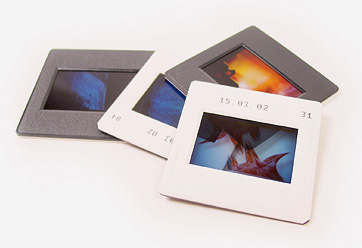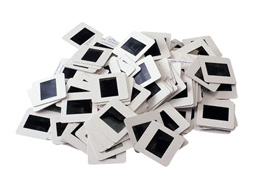3 Ways to Digitise Slides
- Details
- Published: Thursday, 02 April 2015 15:00

Looking to digitise your slides? Here's three of the most common methods used to bring your images into the digital age.
In-house
The first thing you need to remember when digitising slides yourself is that it's important to clean the slides before you attempt to create digital images. Even if you don't notice it, your slides will be holding tiny specks of dust and dirt which will show up on digital images and potentially ruin the quality of the image. You will need to use a non static cloth or air compressor to remove the dust beforehand.
Once the image is cleaned, there are two common methods for digitising the slides. The first, and most common, method is to use a flat-bed scanner. Most offices have a flat-bed scanner so this can often seem like the most convenient solution but you will need to ensure that the scanner you want to use has 'film capability' otherwise it won't be able to recognise materials like slides and negatives. As PC advisor states;
"Scanners will cope with most slides but the automatic exposure could be fooled with scenes containing lots of white (e.g. a snowy scene) or lots of black. If, as a result, your whites or blacks come out as grey you'll need to override the automatic exposure."
This method is suitable for a small volume of slides but once you get into bigger volumes, it can be incredibly time consuming and is not advisable if you can't dedicate the time to it.
The second method is to use a digital camera to take a high quality picture of the slide. This is where things can get pretty technical if you're not used to using anything more than a 'point and shoot' camera. You'll have to put your camera into 'macro' mode, ensure you have optimum focus on the slide and let the slide take up as much of the shot as possible to avoid the need to crop as cropping will decrease the resolution of the digital image. Backlighting the image will also ensure a crisp image is captured.
This method is commonly used but can be even more time consuming than the flatbed scanner method and you will definitely need to know your way around a good quality digital camera.
Outsource
If you know you don't have a great deal of time to put aside for the project, it is advisable not to attempt it yourself. Instead, the third method is to seek a professional scanning service and there are plenty who can do the work for you.
When outsourcing the work, it is important to take some factors into consideration before deciding on a company to complete the work for you.
1. Is the cost reasonable for the service you are expecting?
While a lot of us will automatically search for the cheapest service, you also need to check that the scans you will receive will be of the quality you are expecting. Sometimes a cheap service will give you a cheap looking outcome.
2. How will you get your slides to them?
This may not have been something you had already thought about but it is important. If your first thought was "I'll just box them up and send them in the post" then you might want to think again. I'm assuming that since you are digitising the images, they are important to you in some way so why do you want to risk the loss or damage or them by sending them in the post? It is highly advisable to choose scanning services that offer collection services or ones close enough for you to be able to drop them off.
3. Could I do this work quicker and cheaper myself?
For very small volume scanning projects, it can sometimes be cheaper to do the digitising yourself but with large scale projects, many companies will offer significant discounts the more you scan.
The main draw of professional scanning companies is that they will do the work for you (usually using much better equipment than you can get your hands on) so you don't have to worry.
Pearl Scan Solutions
We are a scanning company that specialises in the scanning of slides, photos and negatives and we offer a bespoke scanning service which can be tailored to suit the needs of each individual client.
Our process is simple; we collect your slides from anywhere in the UK using our secure nationwide collection services. Once your slides are at our scanning bureau they will be scanned in the highest quality available using our super-fast scanners. The digital images will then be checked for quality and re-touched if needed. Finally, you files will be fully indexed and placed onto the medium of your choice (CD, DVD, USB etc.). The digital images will then be delivered to you in a quick turnaround time.
If you would like some more information about how we scan negatives and what benefits you can gain from it, check out our website or give us a call to discuss your requirements.
Request a Quote | Contact Us | This email address is being protected from spambots. You need JavaScript enabled to view it.
The Scan-do Peopletm
For more information feel free to give us a call:
Nationwide: 0845 22 55 923 London: 0207 183 1885
Manchester: 0161 832 7991 Birmingham: 0121 285 1900





